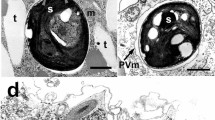Abstract
A CHARACTERISTIC morphological pattern of organization of mitochondrial structure has been repeatedly described by Palade1, Sjöstrand2, Rhodin3 and various other workers using electron microscope studies, according to which each mitochondria consists of a limiting membrane, cristæ and the mitochondrial matrix with granules or particles in it. During the cytochemical study of the oocytes of the various freshwater fishes, I4,5 have defined a cytochemical pattern of mitochondrial structure. The mitochondria of the fish oocytes are granular filaments with uniform thread-like contour. Such a structure is revealed both vitally under phase-contrast microscope6 and cytochemically in the tissue prepared according to Baker's7 lipid preserving formaldehyde-calcium fixative. A similar structure is seen in the tissue fixed in osmium solution or osmium-containing fixatives, that is, Champy's and Lewitsky's (Flemming-without-acetic) fluids. However, their filamentous structure is completely destroyed in fat solvents or fixatives consisting fat solvents and strong acids, for example, Bouin and Carnoy's fluid, after which treatment their fine granules are observed to be randomly scattered in the cytoplasm. The mitochondrial filaments are coloured deep blue in sudan black B but this deep coloration is confined more rigidly at the periphery and at the interspaces between the fine granules of mitochondrial filaments. The granules in the mitochondria remain distinct by their feeble coloration in sudan black B. The peripheral sudanophil material is positive to Baker's7 acid-hæmatin technique revealing phospholipids, but is completely negative to all other lipid tests. Its exclusive lipid nature is further revealed by its negative reactions to Mazia's8 mercuric-bromophenol blue test for proteins, and by periodic acid-Schiff technique for carbohydrates. The granular component of mitochondria consist of abundant proteins, and in addition show some lipo-proteins revealed by Pearse's9 extractive technique. Thus the mitochondria structure consists of a basal phospholipid sheath, in which numerous protein granules are embedded.
This is a preview of subscription content, access via your institution
Access options
Subscribe to this journal
Receive 51 print issues and online access
$199.00 per year
only $3.90 per issue
Buy this article
- Purchase on Springer Link
- Instant access to full article PDF
Prices may be subject to local taxes which are calculated during checkout
Similar content being viewed by others
References
Palade, G. E., J. Histochem. and Cytochem., 1, 188 (1953).
Sjöstrand, F. S., Nature, 171, 30 (1953).
Rhodin, J., Sjöstrand, F. S., Exp. Cell Res., 4, 426 (1953).
Chopra, H. C., Quart. J. Micro. Sci., 2, 149 (1958).
Chopra, H. C., Res. Bull. Panj. Univ., 152, 211 (1958).
Nath, V., Res. Bull. Panj. Univ., 98, 145 (1957).
Baker, J. R., Quart. J. Micro. Sic., 87, 441 (1946).
Mazia, D., Brewer, P., and Alfert, M., Biol. Bull., 104, 57 (1953).
Pearse, A. G. E., “Histochemistry” (London, Churchill).
Schmidt, W. A., Nora Acta Leop., 7, 1 (1939).
Baker, J. R., J. Histochem. and Cyotchem., 6, 303 (1958).
Criegee, R., J. Liebigs Ann. Chem., 522, 75 (1936).
Author information
Authors and Affiliations
Rights and permissions
About this article
Cite this article
CHOPRA, C. Cytochemical Study of Mitochondrial Structure. Nature 184, 656–657 (1959). https://doi.org/10.1038/184656a0
Issue Date:
DOI: https://doi.org/10.1038/184656a0
This article is cited by
Comments
By submitting a comment you agree to abide by our Terms and Community Guidelines. If you find something abusive or that does not comply with our terms or guidelines please flag it as inappropriate.



